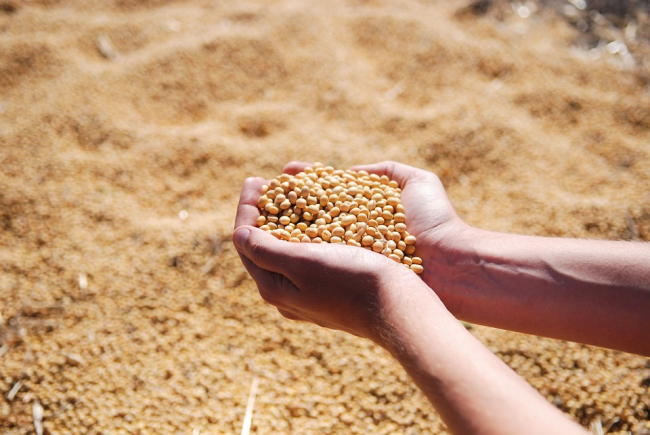
Soybeans are among the largest-cultivated legumes in the world. The crop originated from East Asia, and it is now common in most parts of the world, including the Western. In most cases, soybean cultivation is prominent because of oil production. The seeds contain 18% of oil, making them more preferable than other plants.
Another advantage of cultivating soybeans is that they can be a direct source of food. Other uses include the manufacture of animal feeds, soy proteins, soy milk, and industrial uses. The crop is easy to manage, and it grows in climates where the cultivation of corn is possible. In 2017 alone, the U.S. Soybean Export Council recorded US$ 22.8 billion of sales, making it the second-largest exporter of soybean products.
You can grow the crop on a large scale or in small portions for domestic use. This plant performs optimally at 85°F. Rains are essential during the early stages of growth. After podding, the rains are only essential in small quantities to keep the plants alive. Too much rain at this stage can damage the crop.
Here is an essential guide you need to follow during the production of soybeans.
1. Seed Selection and Treatment
As a first time cultivator, you should get your beans from a certified seed company for production. The seed stockists will be in the best position to advise you on the best variety that can do well in your region. The ecological aspects determine the yield, quality, and quantity of various types of soybean.
Another advantage of buying prepared and packed seeds is that they are already treated against fungi and nematodes. This makes the cost manageable into one expense.
If you have to use your seeds, choose healthy ones from the fully-developed crop. You need to understand the history of the seed and its yields. The seeds should be well dried and stored away from moisture. Apply the appropriate pesticide and fungicide to preserve the seeds during storage and planting. The most convenient time for seed treatment depends on your projected planting date and soil condition.
2. Land Preparation
Soybeans require proper field preparation. Like corn production, you should plow the field and eradicate all perennial weeds. The soil texture should be an average tilth. If necessary, you may need to harrow the land to reach the appropriate soil tilt for planting the seeds.
In places where ground pests are prominent, treatment may be necessary. Spray appropriate soil treatment a few weeks before planting. However, too much chemical use on the soils can also kill the essential bacteria that leguminous plants need to manufacture proteins. It is best to avoid chemical treatments and consider planting at the most appropriate time with adequate ground moisture.
3. Planting
Planting of soybean is best done during the onset of the rains. However, the optimal soil temperatures should be around 54°F. In places where the winters are warm, early planting is encouraged. Planting is done by seed drilling in straight lines. This makes it convenient to weed and hoe your crop. You will also spend fewer seeds per acre when planting in lines compared to broadcasting.
While planting, allow a spacing of 45 to 60 cm between the lines. Drill the seeds at 2.5 cm apart. Spacing varies according to the purpose of production. For grain production, you need more spacing than those intended for fodder. Averagely, you would need 20-30kg/ha for seed harvesting and 70-80kg/ha for foliage. Plant your soy seeds 1 to 1.5 inches deep.
4. Fertilizer Application
Being legumes, soybeans can get their nitrogen supply from the atmosphere. However, this alone is not adequate. You will need to supplement the supply with nitrogenous fertilizers. With fertilizer application, the crop yield is higher. You need to supply the beans with between 10% and 15% of the total nitrogen requirement.
Fertilizers are best applied during the sowing. Apply about 50Kg Nitrogenous fertilizers per hectare for optimal performance. Phosphates are also necessary, and you should use about 100kg per hectare.
5. Field Operations
As with any other crop, weeding is necessary for soybean production. The best time to weed the fields is when there is minimal dew and rain. You should not handle the crop when wet because of fungus transmission. Use a hoe to remove weeds, taking care not to disturb the roots and cause the plants to wilt or dry.
Mulching is preferred if you are growing soybean when there is minimal rain. The mulch will preserve the soil moisture during warm or hot seasons. The operation is not necessary if you cultivate soy only during the rainy season or in a place with high humidity.
6. Pests and Disease Control
Grasshoppers, caterpillars, and aphids are some of the prominent soybean pests. Most pests feed on the foliage and pods. Others burrow into the ground and feed on the roots. You might be quick to grab your insecticide for pest control in a soybean field. While the step may be effective in protecting the crop, it may also hinder its yield.
Most plant pollinators are insects. As the insects feed on the flower nectar, they transfer pollen and help the plants to fertilize the ovules to make the seeds. Without fertilization, the seeds will not grow, and you will have no yields. While applying insecticides, follow precautionary measures to protect your bean production.
7. Harvesting and Storage
After between 45 and 65 days since planting, your soybean should be ready to harvest. However, if you live at a higher altitude (above 2000m above sea level), your crop may take up to six months to mature. Different varieties do best at different altitudes.
When the crop is ready, it will start to shed the leaves. The pods will be full and dry. Wait for the seeds to reach a 15% moisture content before harvesting. In large scale farming, you would need a threshing machine. Small scale production only requires a sickle or handpicking. Yields can be about 2,000kg/ha.
After harvesting, pod the seeds and dry them. The optimal moisture content is 12%. Use airtight containers to store your harvested beans in a cool, dry, and dark place or sell them immediately.
To Sum Up
Soybean is the second-largest field crop in the US. Its value and use have led to widespread production. Most of its production goes to oil and fodder for the meat industry. Whether you want to produce soy for consumption or business, you can achieve your goals as it has a high yield, and it takes a short period to mature.

